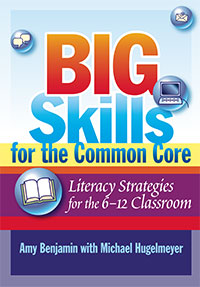CCSS Literacy Explained
Big Skills for the Common Core: Literacy Strategies for the 6 -12 Classroom
By Amy Benjamin with Michael Hugelmeyer
(Eye on Education/Routledge, 2013 – Learn more)
Two MiddleWeb reviewers agree: Big Skills for the Common Core provides ELA educators and content teachers with easy-to-use strategies to help students grasp the elements of the Common Core.
First up, middle grades educator and English Language Arts supervisor Joan Cansdale.
The difference between a skill and a strategy is that a skill is automatic, but a strategy requires conscious thought about how to put a plan into action…(Students) should be continuously using strategies for learning that, through practice, become skills.” (page xi)

In the introduction, Benjamin and Hugelmeyer thoughtfully distill each of the anchor standards and insert these thumbnail descriptions next to the complete wording of the standards in four charts, one for each of the four strands of the ELA CCSS: Reading, Writing, Speaking and Listening, and Language. These “Big Skills” focus the reader on the essence of the standards, and teachers will find this chart useful in discussing the standards with students.
T
This point of view is a great strength of the book, as the authors consistently include content area examples and considerations as part of the discussion. In the Reading “Classroom Close-Up” section, for example, anecdotes include two social studies classes, two science classes, and an English class. In Part 2, Writing, we are treated to an explanation of how proper syntax supports students’ learning of scientific concepts when teacher “Mrs. L” provides students with templates using compound sentences, appositives, and punctuation as a means of expressing scientific relationships.
My favorite part of the book, however, occurs in Chapter 15: Grammar and the Common Core. In a chart that spans three pages, the authors explain “How Knowing about Parts of Speech Fits into the Writing Process.” As an English Language Arts teacher, I’ve always struggled with integrating grammar instruction into the writing process in a way that is relevant and effective. This chart details just how to do that! The authors show how focusing on a specific part of speech during the revision process can allow students to use their understanding of grammar to improve the content and style of their writing.
Finally, Benjamin and Hugelmeyer provide appendices that include writing rubrics, academic word lists, and checklists that are also available as downloads, along with other supplemental materials, from the publisher’s website.
The authors remind us that, “Skills magnetize content. Strategies, when practiced, lead to skills.” This book will help you and your colleagues use effective and engaging literacy strategies to help your students develop the necessary skills to be truly college and career ready.
Joan Cansdale is a middle grades educator and English Language Arts supervisor. She enjoys networking with other educators on Twitter as @joancansdale. Joan also recently embarked on a mission to read all of Walter Dean Myers’s 105 published titles. She blogs about her progress at http://wdmandme.wordpress.com
____________
Adding her evaluation: Sandy Wisneski, lead teacher at Catalyst Charter Middle, district webmaster, and new-teacher mentor.

I immediately fell in love with the charts that broke down the skills for each anchor standard and put them into teacher-friendly language. What a time saver! No longer did I feel like I was muddling through similar verbiage but found a timesaving skeletal version. Charts contained the “Big Skill” for reading, writing, language, and speaking/listening. These little gems in the introduction were only the beginning.
The heart of the book breaks down each of the standards in depth. Reading and the Common Core addresses two modes of reading. The first mode is meticulous reading at a range of increasingly complex text. This mode of reading requires “grappling with a challenging text.” Big Skills for the Common Core defines text complexity by the following:
- Subtleties. Are there layers of meaning?
- Author’s assumption about the reader. How much background knowledge does the author assume that the reader has?
- Eye appeal. Does the physical layout of the text make it easier or more challenging for the reading?
- Vocabulary. How rare are the words?
- Level of abstraction. The less we can picture and touch something, the more difficult it is to understand it.
- Era in which the text was written. Was it written before the 20th century?
Practice and strategies are divided into two categories: those that are internal and those that are external. Specific strategies for each are interspersed throughout the chapter, including “the punctuation strategy,” “the best title question” and the “why is this part here question.” The toolbox of strategies prepares students for complex texts and a deeper level of complexity. Explanations are practical and can be used at all levels.
While even recreational readers need direct instruction in reading strategies (including guided practice) for specific kinds of text, strategy instruction in the absence of substantial practice in reading (i.e. recreational reading) will never establish the momentum derived from being an actual self-motivated, voluntary reader.”
What a true quote. To become a better reader you need to read a lot. You need to become immersed in books. The classroom needs to become a community of readers. Amy Benjamin points out the drop in “aggressive encouragement for recreational reading” at the middle school level. She emphasizes the need for choice. References to Jim Trelease (2009) and Stephen D. Krashen (2004) support the claims made in the book. “Balance between meticulous reading and recreational reading needs to be a staple in every classroom for the Common Core to be achieved.”
The book’s “Classroom Close-Ups” bring a practical application side to the Common Core. Real classrooms demonstrate how each of the Common Core standards can be implemented. Solid strategies like “THINK Card!” offer an active reader’s model.
- Thoughts: What are your thoughts while reading the selection?
- How: How do the conflicts in the selection drive the overall plot?
- Interpret: Identify and interpret the key quotes that assist in the progression of the selection.
- Need: How are the characters in the selection driven by their needs?
- Know: What do you know about the emerging themes and symbols after reading this section?
It’s a great tool to model active reading!
The same format continues for writing, language, and speaking/listening. Each section breaks down the Common Core Standards into practical strategies that can be used immediately in the classroom. Practical methods teach argumentative, informative, and narrative writing. A favorite section is the mapping and framing structures. The authors present writing structures that break down the process for students into simple guidelines like the “TORT” formula.
- Topic Sentence
- Opinion or argument
- Reason Number 1
- Reason Number 2
- Transition/closing sentences
The book goes beyond the philosophy of the Common Core Standards. It offers research-based ideas that can be implemented in all classes. The authors tackled the Common Core Standards and created a user-friendly book for the busy teacher.
Sandy Wisneski is lead teacher at Catalyst Charter Middle School which opened in the fall of 2013. She is the district webmaster, tech mentor, yearbook advisory as well as new teacher mentor. Over the past 37 years she has become certified as a Flat Classroom Teacher and obtained her masters in reading. She enjoys challenging students to “take ownership” for their learning and to be effective digital citizens in the world.





























